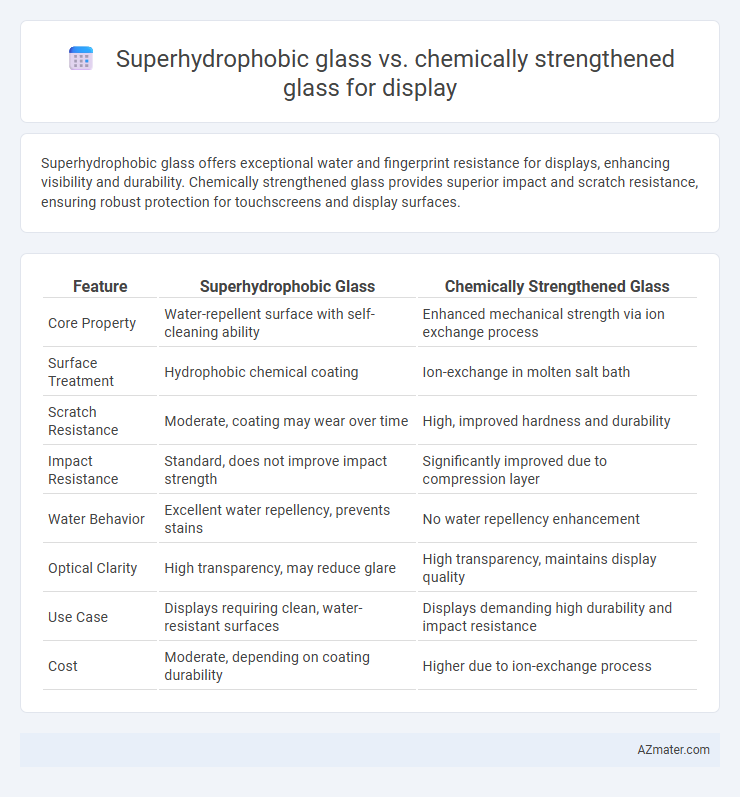Superhydrophobic glass offers exceptional water and fingerprint resistance for displays, enhancing visibility and durability. Chemically strengthened glass provides superior impact and scratch resistance, ensuring robust protection for touchscreens and display surfaces.
Table of Comparison
| Feature | Superhydrophobic Glass | Chemically Strengthened Glass |
|---|---|---|
| Core Property | Water-repellent surface with self-cleaning ability | Enhanced mechanical strength via ion exchange process |
| Surface Treatment | Hydrophobic chemical coating | Ion-exchange in molten salt bath |
| Scratch Resistance | Moderate, coating may wear over time | High, improved hardness and durability |
| Impact Resistance | Standard, does not improve impact strength | Significantly improved due to compression layer |
| Water Behavior | Excellent water repellency, prevents stains | No water repellency enhancement |
| Optical Clarity | High transparency, may reduce glare | High transparency, maintains display quality |
| Use Case | Displays requiring clean, water-resistant surfaces | Displays demanding high durability and impact resistance |
| Cost | Moderate, depending on coating durability | Higher due to ion-exchange process |
Introduction to Display Glass Technologies
Superhydrophobic glass features a nanostructured surface that repels water and dirt, enhancing screen visibility and durability through self-cleaning properties. Chemically strengthened glass, often produced by ion-exchange processes like Gorilla Glass, provides superior scratch resistance and impact durability for touchscreens and displays. These glass technologies optimize device performance by balancing protection with clarity and user experience in modern electronic displays.
What is Superhydrophobic Glass?
Superhydrophobic glass features an ultra-water-repellent surface created by nanostructured coatings that cause water droplets to bead and roll off immediately, enhancing visibility and reducing smudges on displays. This technology contrasts with chemically strengthened glass, which undergoes ion-exchange treatments to improve hardness and impact resistance without altering surface wettability. Superhydrophobic glass is ideal for touchscreens and outdoor displays by minimizing watermarks and fingerprints, thereby improving user experience and display clarity.
What is Chemically Strengthened Glass?
Chemically strengthened glass is a type of safety glass that undergoes an ion-exchange process to enhance its surface strength and resistance to scratches and impacts. Unlike superhydrophobic glass, which is designed to repel water and reduce smudges, chemically strengthened glass improves durability and structural integrity for displays in smartphones, tablets, and other devices. This glass type offers higher resistance to mechanical damage while maintaining optical clarity essential for touchscreen technology.
Surface Properties: Hydrophobicity vs Strength
Superhydrophobic glass features a nanoscale textured surface that creates extreme water repellency with contact angles typically above 150deg, preventing moisture accumulation and enhancing visibility. Chemically strengthened glass undergoes ion-exchange treatments to increase surface compressive stress, resulting in enhanced mechanical strength and resistance to scratches and impacts. While superhydrophobic glass optimizes hydrophobicity for cleaner displays, chemically strengthened glass prioritizes durability and structural integrity, making their surface properties distinct yet complementary for advanced display applications.
Durability and Scratch Resistance Comparison
Superhydrophobic glass features a nanoscale textured coating that repels water, enhancing self-cleaning properties but often offering moderate scratch resistance due to its delicate surface layer. Chemically strengthened glass undergoes an ion-exchange process that increases surface compression, significantly improving durability and superior scratch resistance critical for high-use display applications. When comparing durability, chemically strengthened glass typically outperforms superhydrophobic coatings by maintaining structural integrity under impact and abrasive wear, while superhydrophobic glass prioritizes water repellency over mechanical toughness.
Optical Clarity and Display Performance
Superhydrophobic glass enhances display performance by repelling water and reducing smudges, maintaining high optical clarity through minimized surface contamination. Chemically strengthened glass offers superior mechanical strength and scratch resistance but may introduce slight surface distortions that can affect light transmission and display sharpness. Both types prioritize optical clarity, yet superhydrophobic coatings provide better long-term visual performance by preserving screen cleanliness and reducing glare.
Fingerprint and Smudge Resistance
Superhydrophobic glass offers superior fingerprint and smudge resistance due to its water-repellent nanostructured surface that effectively prevents oils and moisture from adhering. Chemically strengthened glass provides durability and scratch resistance but is more prone to fingerprint accumulation because its smooth surface lacks oleophobic properties. For display applications prioritizing clean visuals, superhydrophobic glass significantly reduces maintenance and enhances touch experience by minimizing smudges and fingerprints.
Cost and Manufacturing Considerations
Superhydrophobic glass involves complex nano-coating processes that increase manufacturing costs due to specialized equipment and materials, while chemically strengthened glass requires ion-exchange treatments offering more scalable and cost-effective production for large displays. The durability of chemically strengthened glass under mechanical stress enhances its suitability for mass production, reducing replacement expenses. Superhydrophobic coatings add anti-fingerprint and water-repellent features but may require costly reapplication or maintenance over time, impacting overall lifecycle costs.
Application Suitability: Which Glass for Which Display?
Superhydrophobic glass offers exceptional water and dirt repellency, making it ideal for outdoor or high-humidity display environments where clarity and cleanliness are critical, such as smartwatches, smartphones, or public kiosks exposed to weather. Chemically strengthened glass provides superior mechanical strength and scratch resistance, making it suitable for high-impact or heavy-use displays like tablets, laptops, and industrial touchscreens requiring durability and safety. The choice depends on environmental exposure and usage, with superhydrophobic glass best for moisture-prone scenarios and chemically strengthened glass preferred for impact-intensive applications.
Future Trends in Display Glass Technologies
Superhydrophobic glass enhances display durability by repelling water and reducing smudges, improving touch sensitivity and visibility in various environmental conditions. Chemically strengthened glass, employing ion exchange processes, offers superior scratch resistance and structural integrity essential for foldable and flexible displays. Future trends in display glass technologies emphasize combining superhydrophobic coatings with chemically strengthened substrates to develop ultra-durable, smudge-resistant, and bendable screens for next-generation smartphones and wearable devices.

Infographic: Superhydrophobic glass vs Chemically strengthened glass for Display
 azmater.com
azmater.com